Complete Solutions to Single correct answer type of chapter MISCELLANEOUS VOLUME 3 of Class 12 book with complete answers and questions
| Class 12 | PHYSICS |
| Chapter | MISCELLANEOUS VOLUME 3 |
| CENGAGE PHYSICS | Single correct answer type |
| Number Of Questions | 100 |
| Academic Year | 2023-24 |
In the given circuit diagram figure, switch `S_w` is shifted from position 1 to position 2. Then

View SolutionConsider a capacitor as shown in figure. If we pull the plates of capacitor apart to a final position as shown in figure, then we must perform some work against the electric force. For this situation, mark out the correct statements.

View SolutionCapacitor `C_1` is connected to a battery and charged till the magnitude of the charge on each plate is `q_0`. Then, the battery is disconnected and `C_1` is connected to two other uncharged capacitors `C_2 and C_3` as shown in figure. Final charges on the capacitors `(q_1,q_2 and q_3)` are related by .
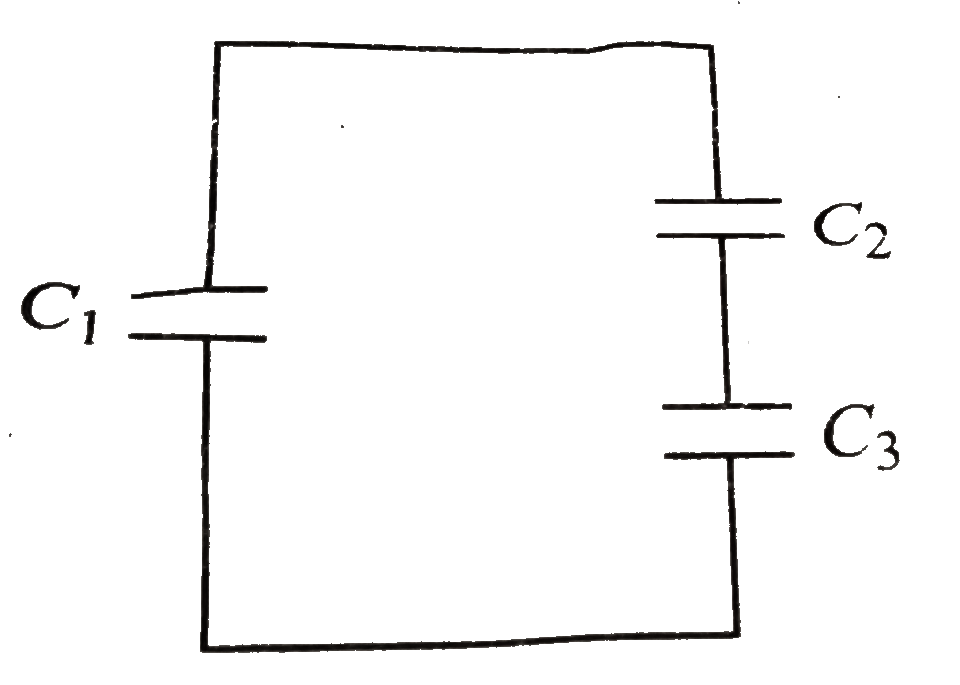
View SolutionThree concentric conducting spherical shells have radii r, 2r, and 3r and charges `q_1,q_2 and q_3`, respectively. Innermost and outermost shells are earthed as shown in figure. The charges shown are after earthing. Select the correct alternative.

View SolutionA uniformly charged and infinitely long line having a linear charge density `'lambda'` is placed at a normal distance `y` from a point `O`. Consider a sphere of radius `R` with `O` as centre and `Rgty`. Electric flux through the surface of the sphere is
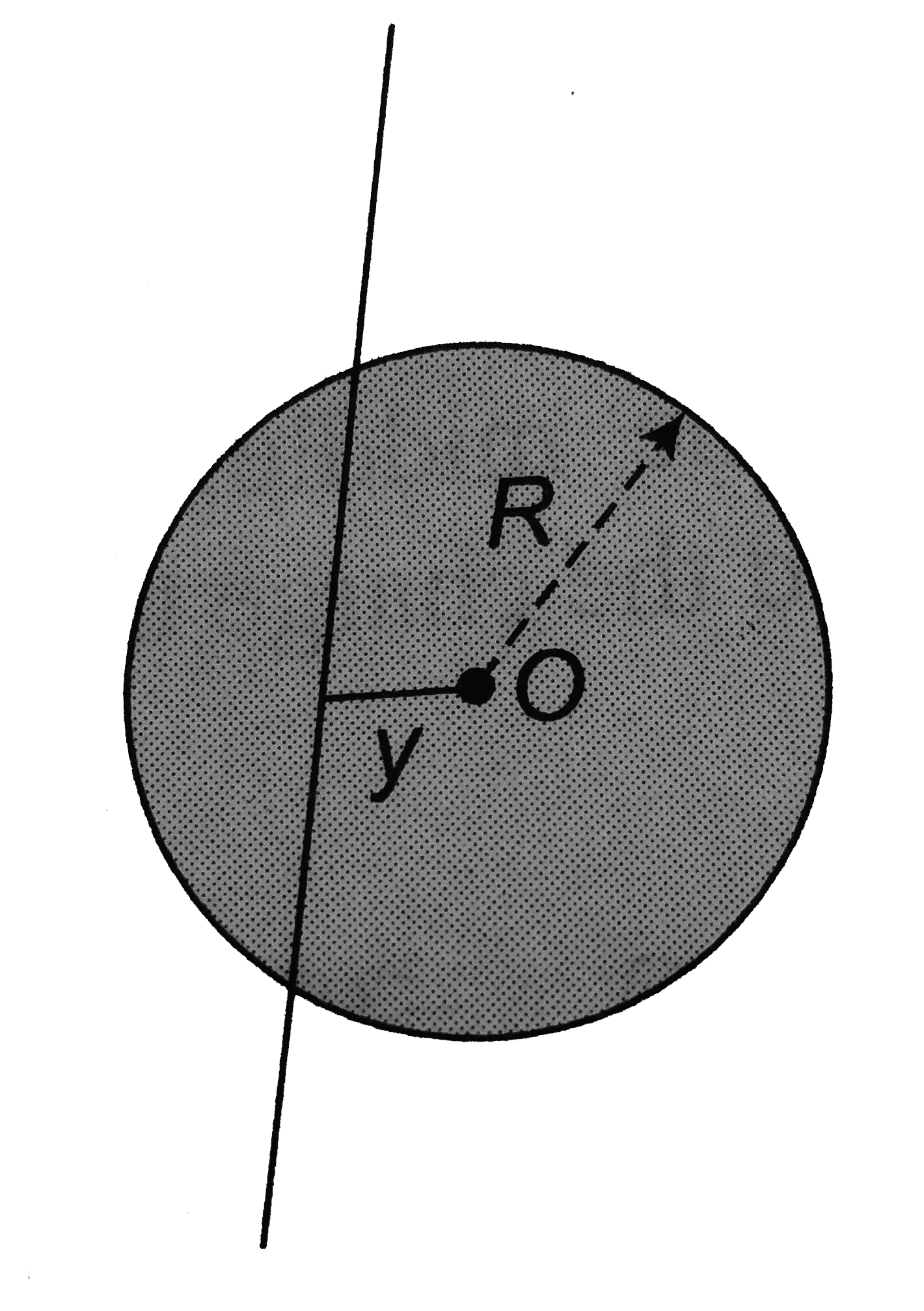
View SolutionA point charge +Q is placed at the centroid of an equilateral triangle. When a second charge +Q is placed at a vertex of the triangle, the magnitude of the electrostatic force on the central charge is 8 N. The magnitude of the net force on the central charge when a third charge +Q is placed at another vertex of the triangle is
View SolutionThere are four light weight rod samples A,B,C and D separately suspended by thread. A bar magnet is showly brought near each sample and the following observations are noted
View SolutionThe negative charge `-q_2` is fixed, while positive charge `q_1` as well as the conducting sphere S is free to move figure. If the system is released from rest,

View SolutionA charged particle of mass m = 2 kg and charge `1 muC` is projected from a horizontal ground at an angle `theta=45^@` with speed `10ms^(-1)`. In space, a horizontal electric field towards the direction of projection `E = 2 xx 10^(7) NC^(-1)` exists. The range of the projectile is
View SolutionA wire of linear charge density `lambda` passes through a cuboid of length l, breadth b and height h(l>b>h) in such a manner that the flux through the cuboid is maximum. The position of the wire is now changed, so that the flux through the cuboid is minimum. The raito of maximum flux to minimum flux will be
View SolutionA positively charged particle P enters the region between two parallel plates with a velocity u, in a direction parallel to the plates. There is a uniform electric field in this region. P emerges from this region with a velocity v. Taking C as a constant, v will depend on u as

View SolutionConsider the situation shown in figure. We find electric field E at point P using Gauss's law and it comes out to be `E = sigma//epsilon_0`. This electric field is due to

View SolutionFour charges are placed at four corners of a square as shown in figure. The side of the square is a. Two charges are positive and two are negative, but their magnitudes are the same. Now, an external agent starts decreasing all the sides of the square slowly and at the same rate. What happens to the electrical potential energy of the system and what will be the nature of work done by the agent?
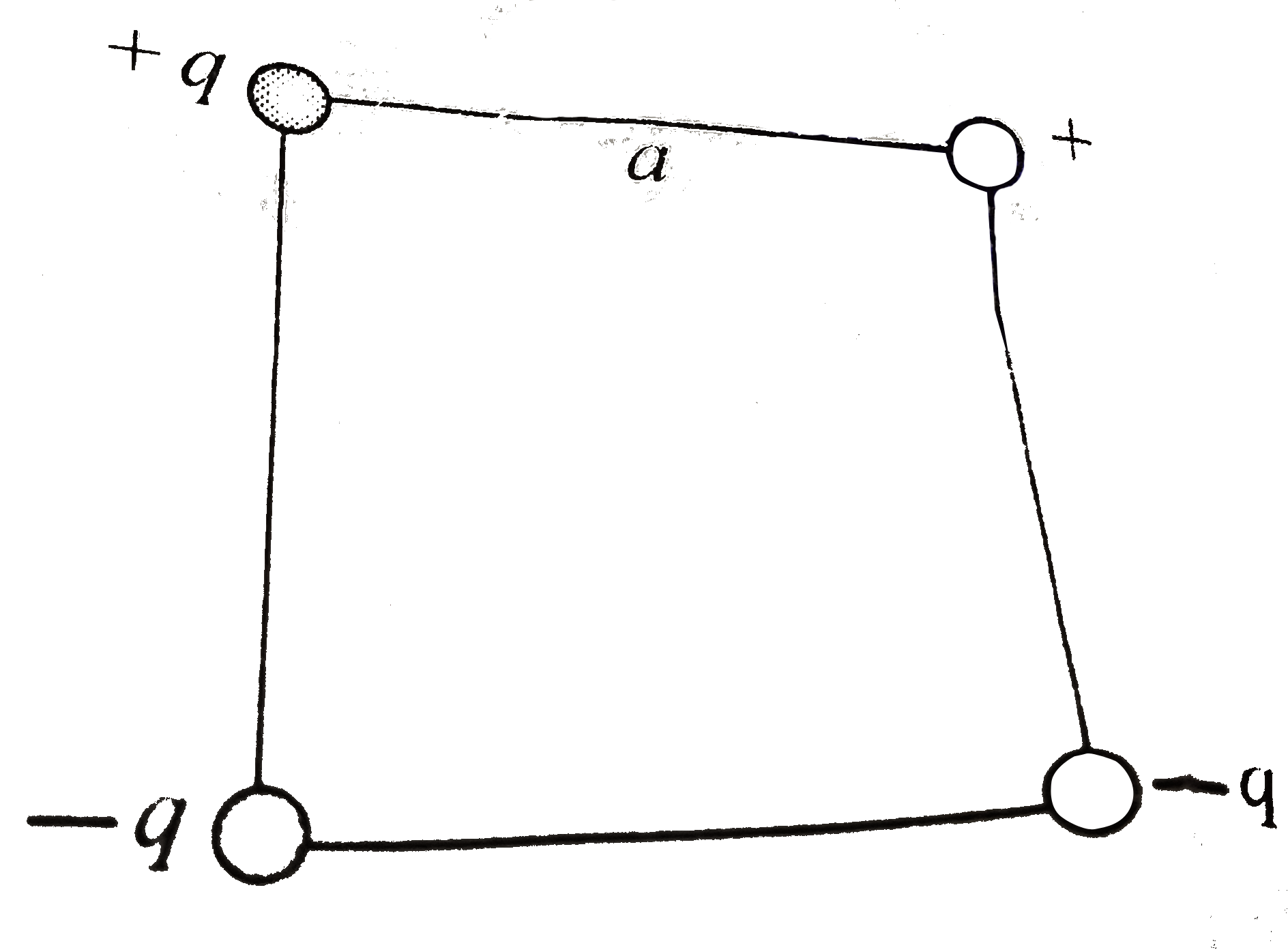
View SolutionAt a distance r from a point located at origin in space, the electric potential varies as `V= 10r`. Find the electric field at `vecr = 3hati + 4 hatj - 5hatk`.
View SolutionA conducting spherical shell is earthed. A positive charge `+q_1` is placed at the center and another small positive charge `+q_2` is placed at a distance r from `q_1`. Ignore the effect of induced charge due to `q_2` on the sphere. Then the coulomb force on `q_2` is

View SolutionIn question 15, if the conducting spherical shell is not earthed but is neutral, then the force on `q_2` is
View SolutionTwo parallel conducting plates, each of area A, are separated by a distance d. Now, the left plate is given a positive charge Q. A positive charge q of mass m is released from a point near the left plate. Find the time taken by the charge to reach the right plate.

View SolutionA uniform electric field to 100 `Vm^(-1)` is directed at `60^@` with the positive x-axis as shown in figure. If OA= 2 m, the potential difference `V_O - V_(A)` is

View SolutionA graph of the x-component of the electric field as a function of x in a region of space is shown in figure. The `y- and z-components ` of the electric field are zero in this region. If the electric potential is 10 V at the origin, then the potential at x = 2.0 m is

View SolutionAn uncharged conductor A is brought near a positively charged conductor B. Then.
View SolutionInside a hollow conducting sphere, which is uncharged, a charge q is placed at its center. Let electric field at a distance x from center at point p be E and potential at this point be V. Now, some positive charge Q is given to this sphere, then

View SolutionA charge particle moves in a circle around an infinite line charge with the center of circle at the line and line being perpendicular to the plane of circle. Let r be the radius of circle. The velocity of the particle depends upon which power of r.
View SolutionTwo large plates are given the charges as shown in figure. Now, the left plane is earthed. Find the amount of charge that will flow from the earth to the plate.

View SolutionThree identical metallic plates are kept parallel to one another at separations a and b. The outer plates are connected to the ground and the middle plate is given charge Q. Then, the charge on the right side of middle plate is

View SolutionAn electric dipole consists of charges `+- 2.0 xx 10^(-8)` C separated by distance of `+- 2.0 xx 10^(-3)`m. It is placed at a distance of 6 cm from a line charge of linear charge density `4.0 xx 10^(-4) Cm^(-1)` as shown in figure such that the dipole makes an angle of `theta = 60^@` with line AB. Find the force acting on the dipole.

View SolutionA `16 muF` capacitor , initially charged to 5 V, is started charging at t=0 by a source at the rate of `40 tmuCs^(-1)`. How long will it take to raise its potential to 10 V?
View SolutionFind the equivalent capacitance between C and B.

View SolutionA parallel plate capacitor of capacitance `10 muF` is connected across a battery of emf 5 mV. Now, the space between the plates of the capacitors is filled with a deielectric material of dielectric constant K=5. Then, the charge that will flow through the battery till equilibrium is reached is
View SolutionThe equivalent capacitance between points A and B is

View SolutionIf the area of each plate is A and then successive separations are `d, 2d` and `3d`, then find the equivalent capacitance across A and B.
 .
.
View SolutionIn the circuit shown in figure, the equivalent capacitance between the points X and Y is
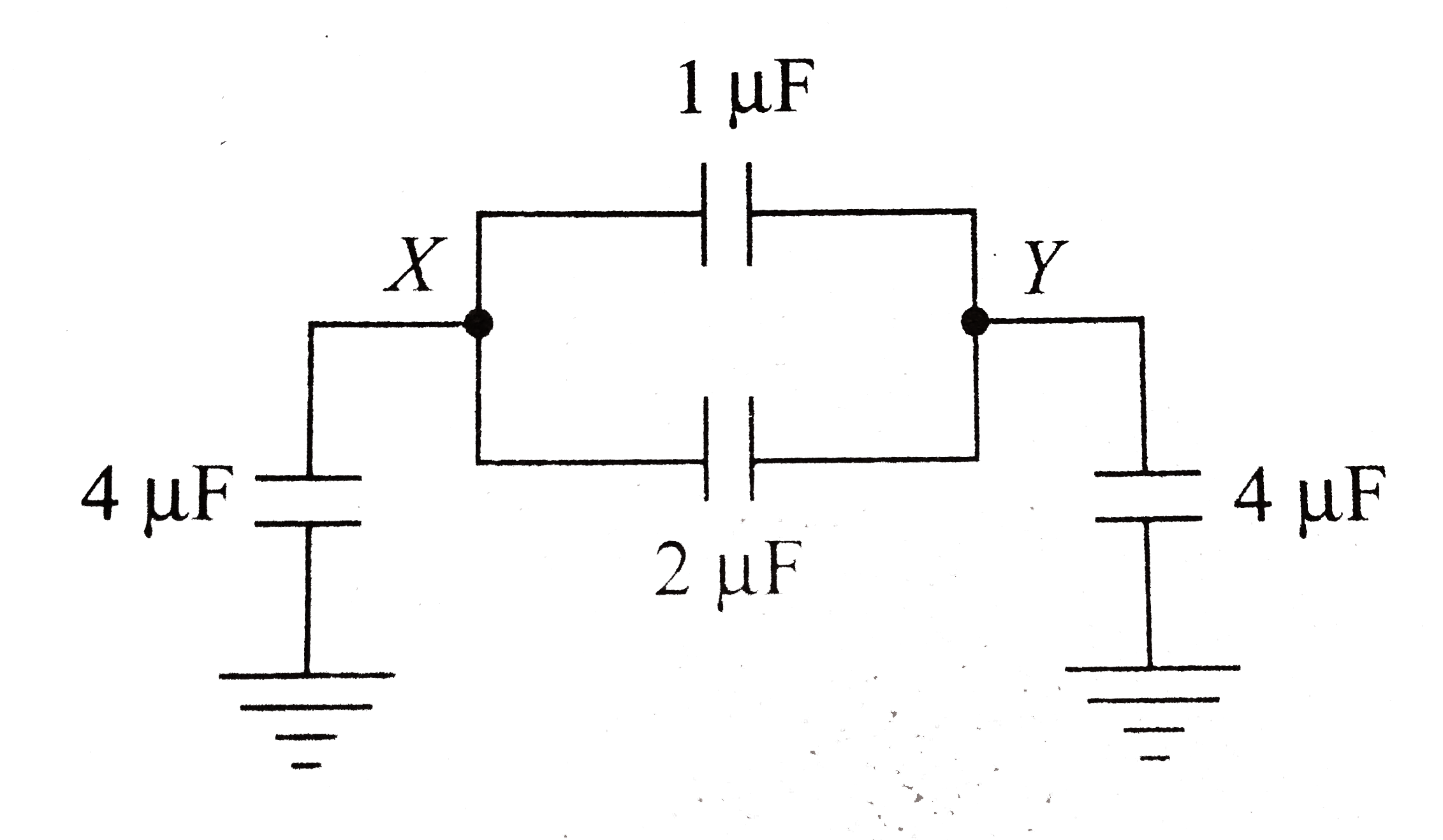
View SolutionAn electric dipole is placed at origin in the xy plane with its orientation along the positive x-axis. The direction is electric field .
View SolutionFor the arrangement shown in figure identify the correct statement.

View SolutionThe electric field in a region is given by `E = (E_0x)/lhati`. Find the charge contained inside a cubical 1 volume bounded by the surfaces `x=0, x=a, y=0, yh=, z=0` and z=a. Take `E_0=5xx10^3N//C` l=2cm and a=1m.
View SolutionThree identical metal plates with large surface areas are kept parallel to each as shown in figure (30-E8). The leftmost plate is given a charge Q, the rightmost a chrgear2Q and the middle one remains neutral. Find the charge appearing on the outer surface of the rightmost plate.

View SolutionThe particle P shown in the figure has a mass of 10 mg and a charge of `-0.01 muC`. Each plate has a surface area `10^(-2) m^2` on one side. What potential difference V should be applied to the combination to hold the particle P in equilibrium?

View SolutionFigure shows two identical parallel plate capacitors connected to a switch `S.` Initially ,the switch is closed so that the capacitors are completely charged .The switch is now opened and the free space between the plates of the capacitors is filled with a dielectric of dielectric constant 3. Find the ratio of the initial total energy stored in the capacitors to the final total energy stored.

View SolutionA point charge q is situated at X between two parallel plates which have a potential difference V and carry charges `+Q` and `-Q`. What is the electric field strength at X ?

View SolutionIn the circuit shown, a capacitance `3muF` is charged form a battery of emf `6V` with switch connected to terminal P. The switch is now connected to Q. This charges the `6muF` capacitor from the `3muF` one. What is the new potential difference across combination?

View SolutionIn the given arrangement of capacitors, `6muC` charge is added to point a. Find the charge on upper capacitor.

View SolutionTwo capacitors A and B with capacities `C_1 and C_2` are charged to potential difference of `V_1 and V_2` respectively. The plates of the capacitors are connected as shown in the figure with one wire free from each capacitor. The upper plate of A is positive and that of B is negative. An uncharged capacitor of capacitance `C_3` and lead wires falls on the free ends to complete circuit, then

View SolutionIn the given electric field `vecE = [alpha(d+x)hati + E_0hatj] NC^(-1)`, where `alpha = 1NC^(-1)` hypothetical closed surface is taken as shown in figure .

The total charge enclosed within the close surface is
View SolutionA spherical conductor `A` contains two spherical cavities as shown in Fig.2.127. The total charge on conductor itself is zero . However , there is a point charge `q_(1)` at the center of one cavity and `q_(2)` at the center of the other cavity . Another charge `q_(3)` is placed at a large distance `r` from the center of the spherical conductor.

If `q_(1)` is displaced from its center slightly (being always inside the same cavity ), then the correct representation of field lines inside the same cavity is
View SolutionThree infinite planes have a uniform surface charge distribution `sigma` on its surfaces. All charges are fixed. On each of the three infinite planes, parallel to the yz plane placed at `x = -a, x =0, and x = a`, there is a uniform surface charge of the same density, `sigma`. The potential difference between A and C is

View SolutionIn the circuit shown in figure, the charge stored on a capacitor of capacitance `3muF` is

View SolutionA parallel plate capacitor is connected to a battery. The plates are pulled apart with uniform speed. If x is the separation between the plates, then the rate of change of electrostatic energy of the capacitor is proportional to
View SolutionFind equivalent capacitance between points `A` and `B`. [Assume each conducting plate is having same dimensions and neglect the thickness of the plate `(epsilon_0A)/d=7muF` where A is area of plate]`
 `
`
View SolutionIf the plates of a parallel plate capacitor are not equal in area, then
View SolutionThree charges q, q, and -2q are fixed on the vertices of an equilateral triangular plate of edge length a. This plate is in equilibrium between two very large plates having surfaces charge density `sigma_1 and sigma_2`, respectively. Find the time period of small anglular oscillations about an axis passing through its centroid and perpendicular to the plane. Moment of inertia of the system about this axis is l.
View SolutionThe capacitor plates are fixed on an inclined plane and connected to a battery of emf E. The capacitor plates have plate area a, length l, and the distance between them is d. A dielectric constant K is inserted into the capacitor and tied to mass M by a massless string as shown in the figure Find the value of M for which the slab will stay in equilibriu. There is no friction between slab and plates.
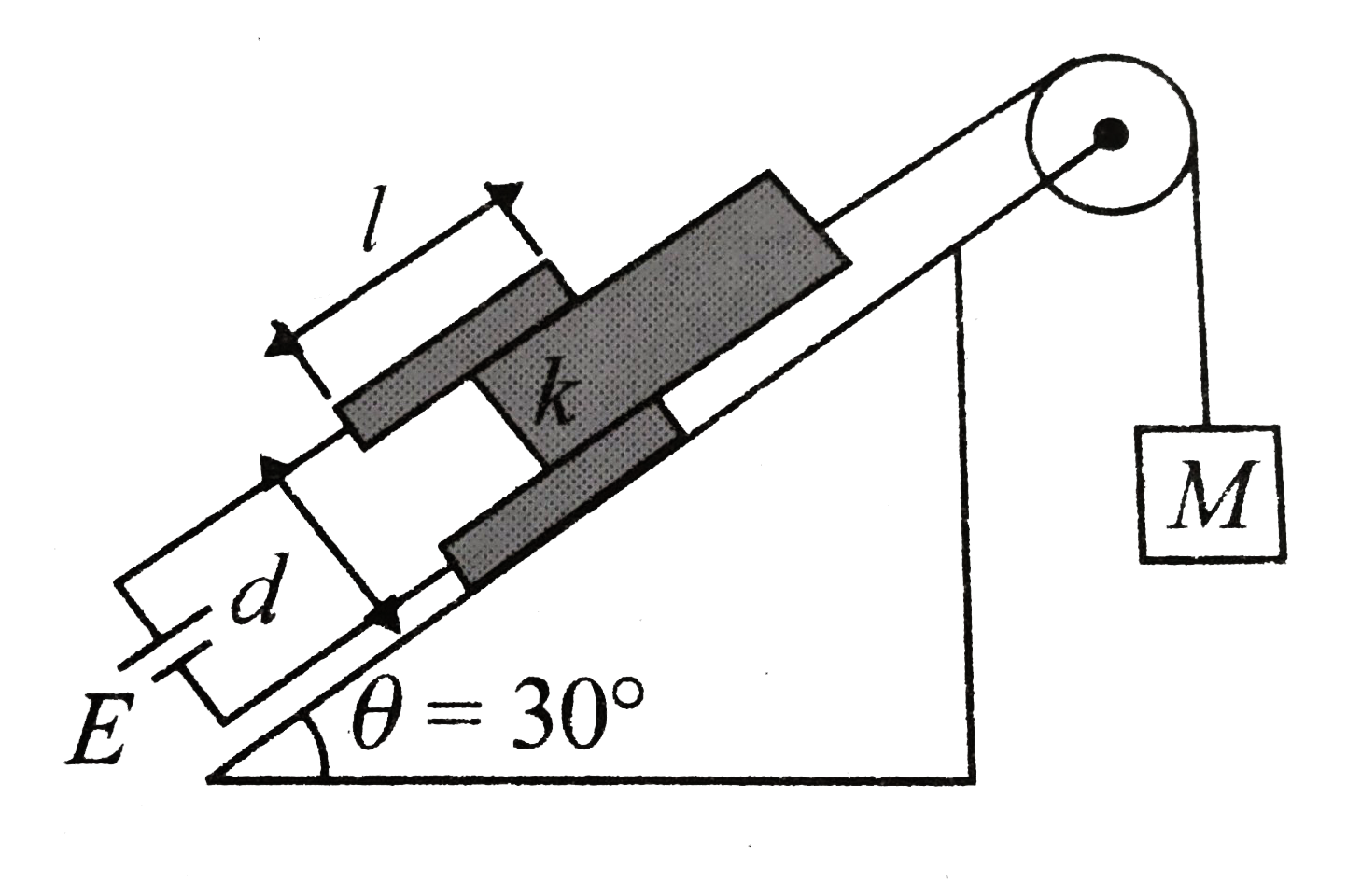
View SolutionTwo plates, each of area A, are placed parallel to each other at a distance d. One plate is connected to a battery of emf E and its negative is earthed. The other plate is also earthed. The charge drawn by plate is

View SolutionA nonconducting sphere with a cavity has volume charge density `rho`. `O_1 and O_2` represent the two centres as shown. The electric fields inside the cavity is `E_0`. Now, an equal and opposite charge is given uniformly to the sphere on its outer surface. The magnitude of electric field inside the cavity becomes

View SolutionFive Styrofoam balls are suspended from insulating threads. Several experiments are performed on the balls and the following observations are made:
(i) Ball A repels C and attracts B.
(ii) Ball D attracts B and has no effect on E.
(iii) A negatively charged rod attracts both A and E.
An electrically neutral Styrofoam ball gets attracted if placed nearby a charged body due to induced charge. What are the charges, if any, on each ball A,B,C,D, and E?
View SolutionThe figure shows two large, closely placed, parallel, nonconducting sheets with identical (positive) uniform surface charge densities, and a sphere with a uniform (positive) volume charge density. Four points marked as 1,2,3, and 4 are shown in the space in between. If `E_1, E_2, E_3, and E_4` are magnitude of net electric fields at these points, respectively, then

View SolutionThree positive point charges `q_1,q_2,and q_3` form an isolated system. Suppose the charges have generated a property due to which like charges also attract. The charges are moving along a circle with same speed maintaining angles as shown in the figure. The charge `q_1` experiences a force `f_1` due to other two charges. Similarly, `q_2` experiences a force `f_2` and `q_3`, a force `f_3`. The ratio of `f_1`:`f_2`:`f_3` is

View SolutionIn the above question, the ratio of masses of the charge particles `q_1,q_2, and q_3` is
View SolutionIn a conducting hollow sphere of inner and outer radii 5 cm and 10 cm, respectively, a point charge 1 C is placed at point A, that is 3 cm from the center C of the hollow sphere. An external uniform electric field to magnitude `20 NC^(-1)` is also applied. Net electric force on this charge is 15 N, away from the center of the sphere as shown. Find the magnitude of net force exerted on the charge placed at point A by the induced charges on the sphere
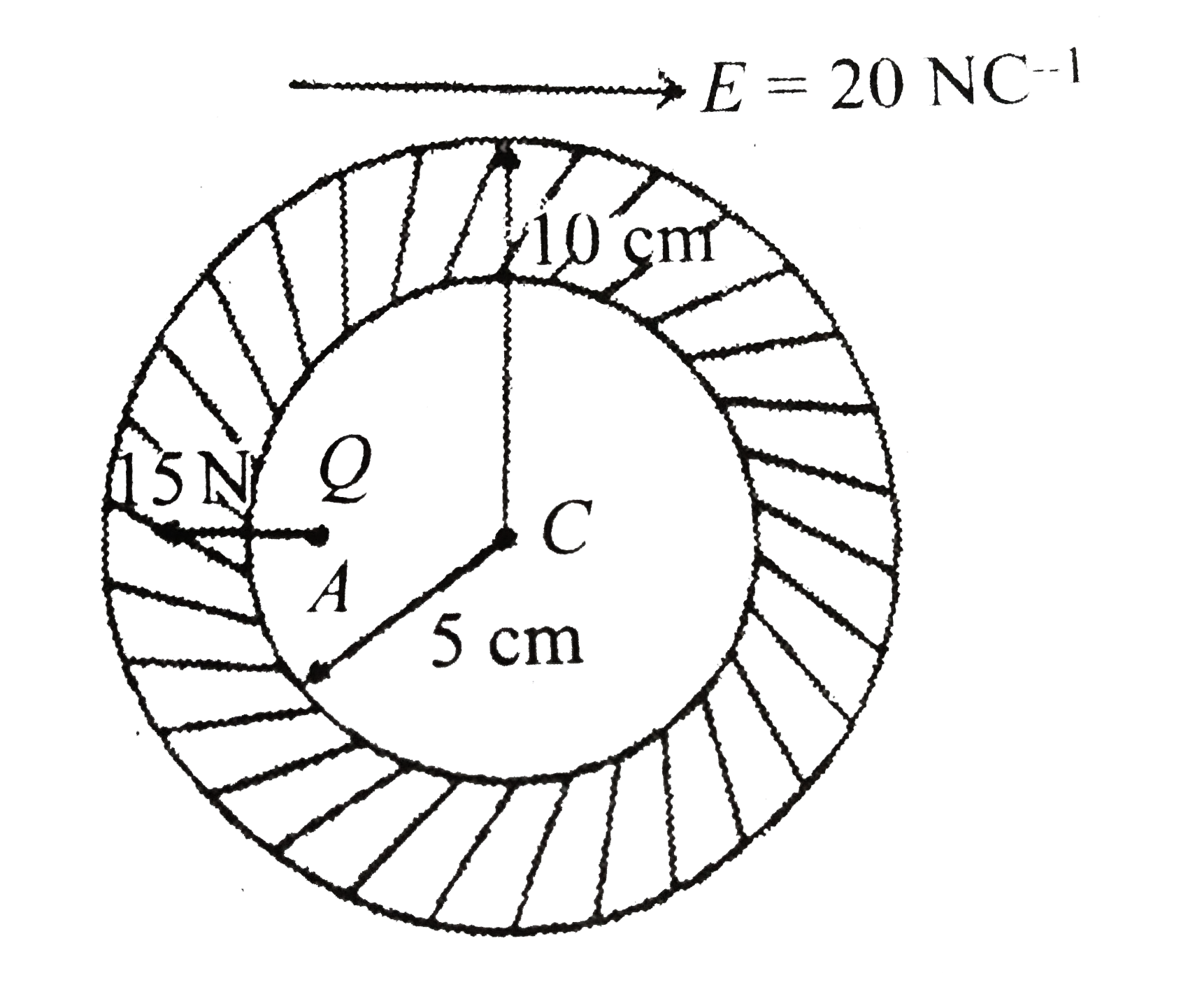
View SolutionConsider two concentric metal spheres. The outer sphere is given a charge `Qgt0`, then
 ,
,
View SolutionA wheel having mass `m` has charges ` +q` and `-q` on diametrically opposite points . It remains in equilibrium on a rough inclined plane in the presence of uniform vertical electric field ` vec E=`
` .
.
View SolutionFind the charge that will flow through the wire A and B if the switch S is closed. The capacitance of each capacitance of each capacitor shown in the figure is C.
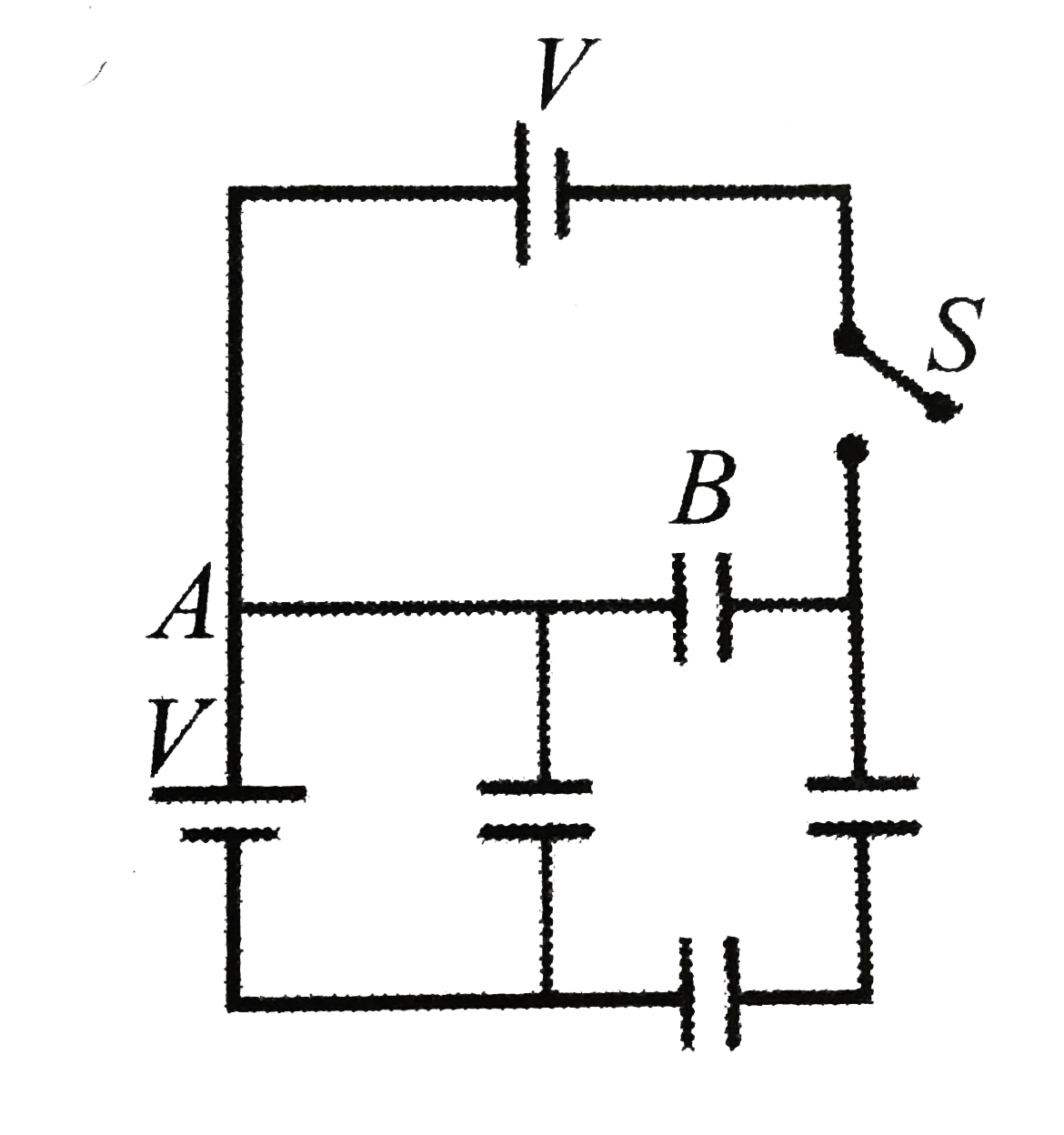
View SolutionAn infinite nonconducting sheet has surface charge density s. There is a small hole in the sheet as shown in the figure. A uniform rod of length l having linear charge density `lambda` is hinged in the hole as shown. If the mass of the rod is m, then the time period of oscillation for small angular displacement is
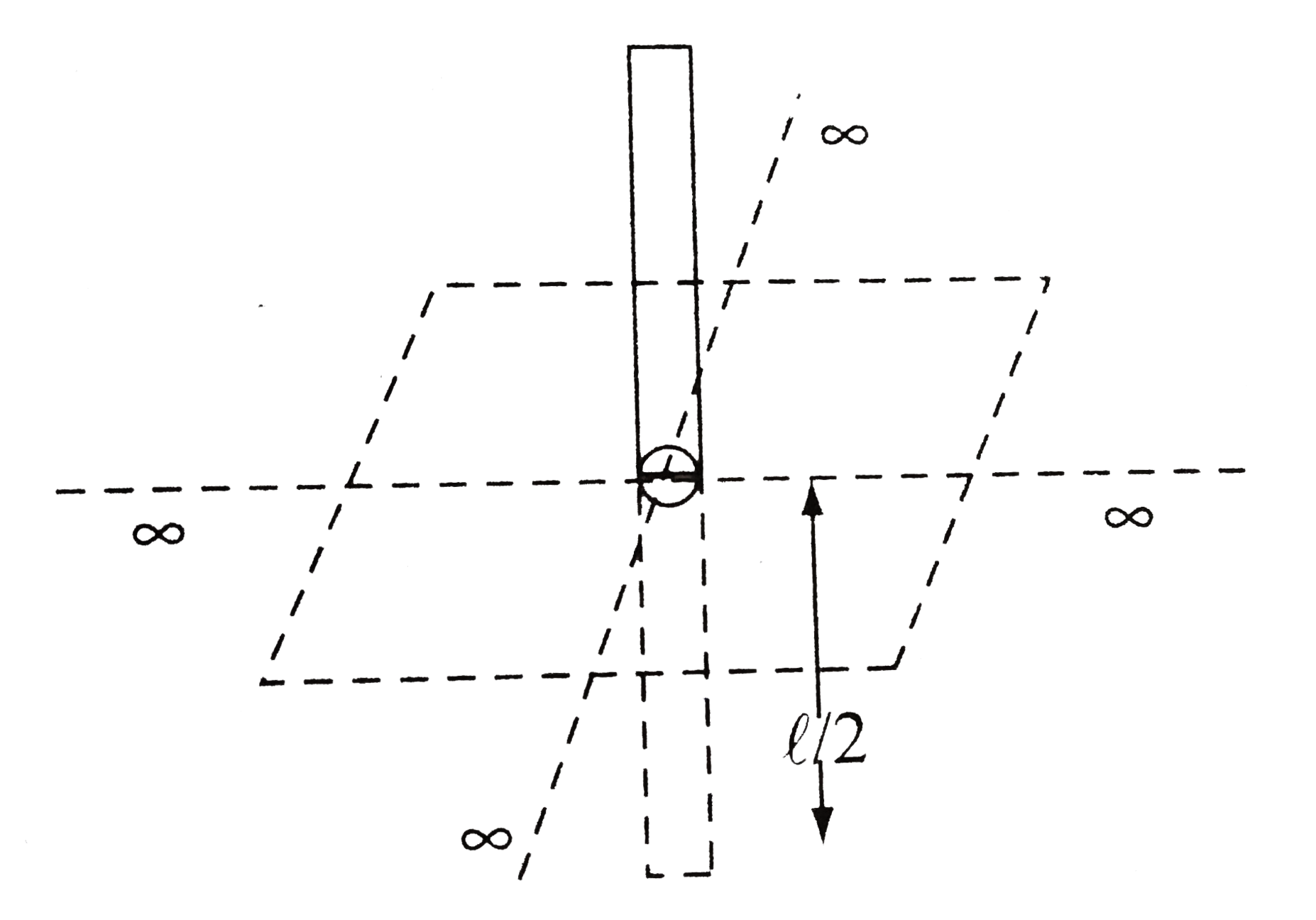
View SolutionThe left plate of the capacitor shown in the figure above carries a charge `+Q` while the right plate is uncharged at `t=0`. The total charge on the right plate after closing the switch will be:

View SolutionTwo point charges of magnitude `+q and -q` are placed at `(-d//2,0,0) and (d//2,0,0)` are respectively. Find the equation of the euipotential surface where the potential is zero.
View SolutionFigure shows equi-potential surfaces, at which point on labeled surfaces will an electron have the highest potential energy ?
 .
.
View SolutionThe effective capacitances between points A and B is (the capacitance of each of the capacitors is C)

View SolutionAn electric dipole is placed in a uniform electric field `vec(E )` of magnitude `40N//C`. Graph shows the magnitude of the square on the dipole versus the angle `theta` between the field `vec(E )` and the dipole moment `vec(p)`. The magnitude of dipole moment `vec(p)` is equal to:

View SolutionThree large plates are arranged as shown. How much charge will flow through the key k if it is closed?

View SolutionThe following diagram shows the electric field lines between two opposite charges. The positive charge is indicated by the black circle, the negative charge by the white circle. An electron strarting from rest at the indicated position `(X)`, and accelerated to high speed by the electric field will follow most likely which trajectory?
View SolutionTwo identical conducting very large plates `P_1 and P_2` having charges `+4Q and +6Q` are placed very closed to each other at separation d. The plate area of either face of the plate is A. The potential difference between plates `P_1 and P_2` is

View SolutionIn the above question, if plates `P_1 and P_2` are connected by a thin conducting wire, then the amount of heat produced will be
View SolutionTwo large identical plates are placed in front of each other at `x = d` and `x = 2d` as shown in the figure. If charges on plates are Q and `-5Q`, the potential versus distance graph for region x = 0 to x = 3d is (d is very small and potential at x = 0 is `v_0`)

View SolutionIn the diagram shown the charge `+Q` is fixed. Another charge `+2q` and mass M is projected from a distance R from the fixed charge. Minimum separtion between the two charge if the velocity becomes `1/sqrt3` time of the projected velocity, at this moment is (Assume gravity to be absent)

View SolutionA cavity of radius r is made inside a solid sphere. The volume charge density of the remaining sphere is `rho`. An electron (charge e, mass m) is released inside the cavity from point P as shown in figure. The centre of sphere and center of cavity are separated by a distance a. The time after which the electron again touches the sphere is

View SolutionAn electric dipole of dipole moment `vecp` is oriented parallel to a unifrom electric field `vecE`, as shown

It is rotated to one of four orientations shown below. Rank the final orientations according to the change in the potential energy of the dipole-field system, most negative to most positive.

View SolutionA battery (or batteries) connected to two parallel plates produces the equipotential lines between the plates as shown. Which of the following configurations is most likely to produce these equipotential lines?

View SolutionA plane sheet has a uniformly distributed charge. Origin is selected at the middle of the sheet (in yz plane). A charge `+Q` is moved from point A (10a, 2a,0) to point B (10a,0,2a) along a circle and then to point C(10a, 0, 0). If the initial electrostatic potential energy is `U_0`, what will be final electrostatic potential energy?

View SolutionCharges `Q_0` and `2Q_0` are given to parallel plates A and B, respectively, and they are separated by a small distance. The capacitance of the given arrangement is C. Now, plates A and B are connected to positive and negative terminals of battery of potential difference `V = 2Q_0//C` respectively, as shown, then the work done by the battery is

View SolutionIn the given circuit, the initial charges on the capacitors are shown in the figure. The charge flown through the switches `S_(1) and S_(2)` respectively after closing the switches are
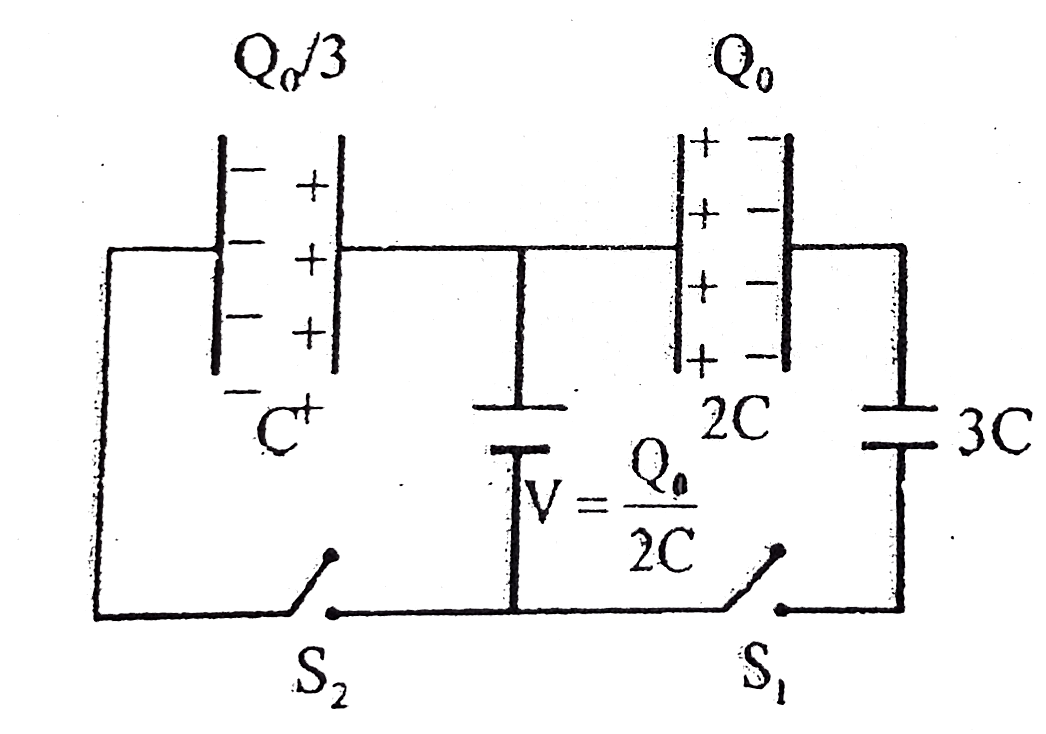
View SolutionFigure shows two capacitors `C_1 and C_2` connected with 10 V battery and terminal A and B are earthed. The graphs shows the variation of potential as one moves from left to right. Then the ratio `C_1//C_2` is

View SolutionIn figure , there are two patterns of electric field lines absent of dielectric and in presence of dielectric slab. The relative permittivity of the dielectric slab is
 ,
,
View SolutionFigure shows the potential due to similarly charged infinite sheets with charge per unit are `sigma_2 and sigma_1`. From examining third plot we can deduce that

View SolutionConsider a uniformly charged hemispherical shell shown in figure. Indicate the directions (not magnitude) of the electric field at the central point `P_1` and an off-center point `P_2` on the drum-head of the shell.

View SolutionA charged ball of mass 9 kg is suspended from a string in a uniform elelctric field `vecE = (3hati + 5hatj) xx 10^5 N//C`. The ball is in equilibrium with `theta=37^@`. If direction of electric field is reversed, find the new equilibrium position of the ball. Given your answer in terms of angle made by string with vertical. Take `g = 10ms^(-2)`.

View SolutionFind the ratio of electric work done in bringing a charge `q` from `A` to `B(W_(AB))` and that from `B` to `C(W_(BC))` in a sphere of charge `Q` distributed uniformly throughout its volume.
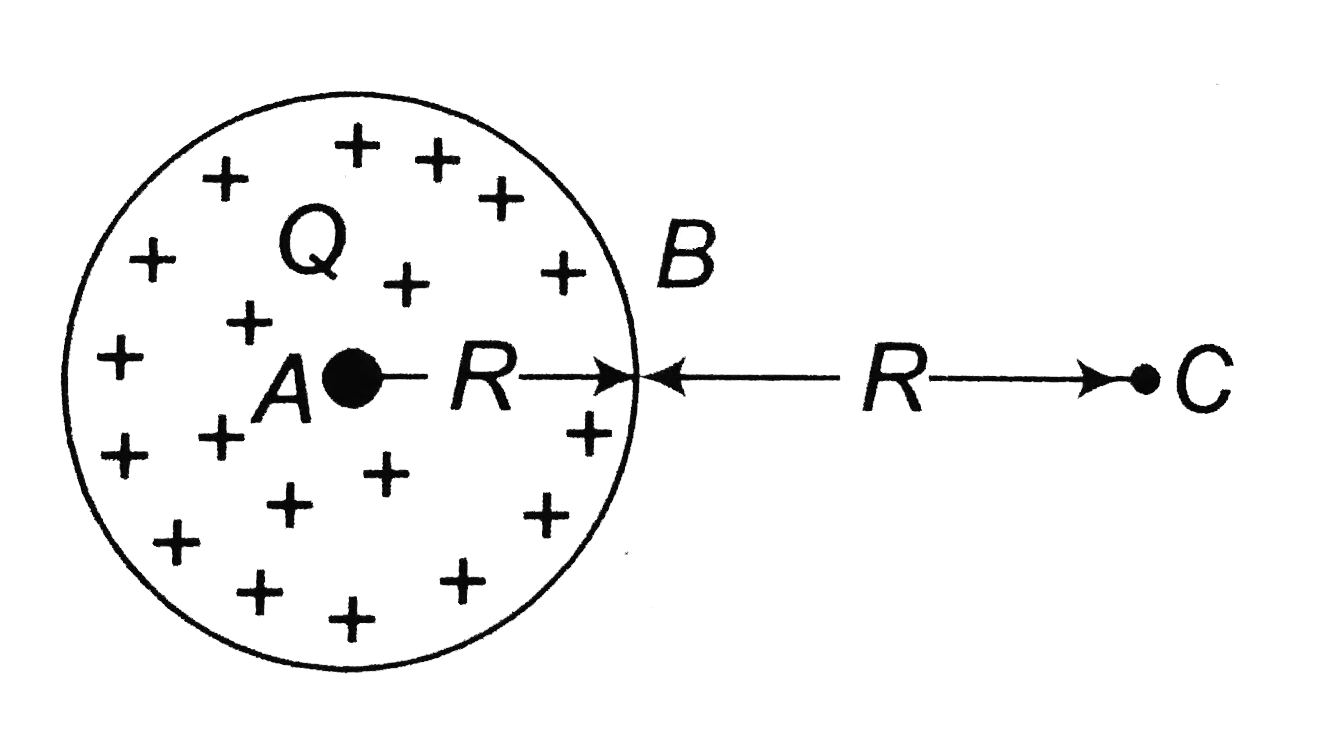
View SolutionGiven are four arrangements of three fixed electric charges. In each arrangement, a point labeled P is also identified. A test charge `+q` is placed at P. All of the charges are of the same magnitude Q, but they can be either positive or negative as indicated. The charged and point P all lie on a straight line. the distances between adjacent items, either between two charges or between a charge and point P, are all the same.
I. `o+,o+,o+,underset (P)(*)`, II. `o+,o+,overset(P)(*),-`
III. `o+,o+,-, overset(P)(*)`, IV. `o+, - , o+, overset(P)(*)`.
Correct order of choices in a decreasing order of magnitude of force on P is
View SolutionA nonuniformly charged ring is kept near an uncharged conducting solid sphere. The distance between their centres (which are on the same line normal to the plane of the ring) is 3m and their radius is 4m. If total charge on the ring is `1muC`, then the potential of the sphere will be
View SolutionAn electron traveling in a uniform electric field passes from a region of potential `V_1` to a region of higher potential `V_2`. Then

View SolutionAn electrically isolated hollow (initially uncharged), conducting sphere has a small positively charged ball suspended by an insulating rod from its inside surface, see diagram

This causes the inner surface of the sphere to become negatively charged. When the ball is centred in the sphere the electric field outside the conducting spehere is
View SolutionA conducting sphere of radius R and a concentric thick spherical shell of inner radius 2R and outer radius 3R is shown in figure. A charge `+10Q` is given to the shell and inner sphere is earthed. Then charge on inner sphere is

View SolutionLet `V_0` be the potential at the origin in an electric field `vecE = 4hati + 5hatj`. The potential at the point (x,y) is
View SolutionIn an electric field shown in figure, three equipotential figure, three equipotential surfaces are shown. If function are shown. If function of electric field is `E=2x^2Vm^(-1)`, and given that `V_1 - V_2 = V_2-V_3`, then we have
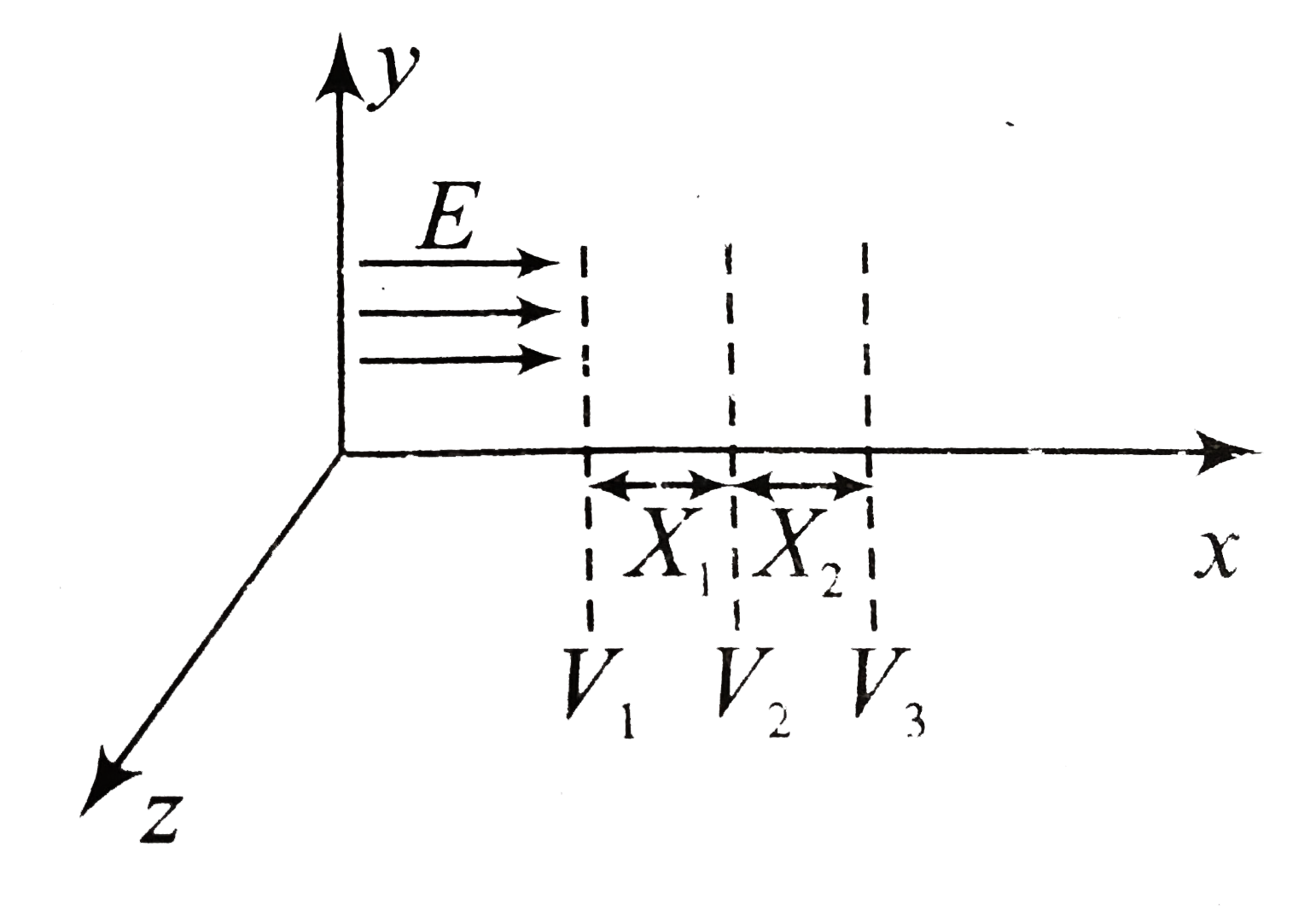
View SolutionElectric dipole of moment `vecp = phati` is kept at a point (x,y) in an electric field `vecE = 4xy^2hati + 4x^2yhatj`. Find the force on the dipole.
View SolutionA positively charged particle of charge q and mass m is suspended from a point by a string of length l. In the space a uniform horizontal electric field E exists . The particle is drawn aside so that it is projected horizontally with velocity v such that the particle starts to move along a circle with same constant speed v. Find the speed v.

View SolutionThe potential of a point B (-20m, 30m) taking the potential of a point A (30m, -20m) to be zero in an electric field `vec E = 10xhati - 20hatj NC^(-1)` is
View SolutionThe corners A, B, C, and D of a square are occupied by charges `q,-q,2Q`, and Q, respectively. The side of square is 2b. The field at the midpoint of side CD is zero. What is the value of `q//Q`?
View SolutionIn a region where intensity of electric field is `5NC^(-1)40` lines of electric force are crossing per square metre. The number of lines crossing per square metre where intensity of electric field is `10NC^(-1)` will be
View SolutionA positive charge `+q_(1)` is located to the left of a negative charge `-q_(2)` On a line passing through the two charges, there are two places where the total potential is zero. The reference is assumed to be at infinity The first place is between the charges and is 4.00 cm to the left of the negative charge. The second place is 7.00cm to the right of the negative charge if `q_(2)=-12muC` , what is the value of charge `q_(1) in muC`
View SolutionA positively charge sphere of radius `r_0` carries a volume charge density `rho`. A spherical cavity of radius `r_0//2` is then scooped out and left empty. `C_1` is the center of the sphere and `C_2` that of the cavity. What is the direction and magnitude of the electric field at point B?

View SolutionThe diagram show a small bead of mass `m` carrying charge `q`. The bead can freely move on the smooth fixed ring placed on a smooth horizontal plane . In the same pane a charge ` +Q` has also been fixed as shown. The potential at the point ` P` due to ` +Q` is `V` . The velocity which the bead should projected from the point `P` so that it can complete a circle should be greater than .

View SolutionA unit positive point charge of mass `m` is projected with a velocity `V` inside the tunnel as shown. The tunnel has been made inside a uniformly charged nonconducting sphere. The minimum velocity with which the point charge should be projected such that it can reach the opposite end of the tunnel is equal to
(##BMS_V03_C03_E01_124_Q01.png" width="80%">
View Solution
Single correct answer type questions and complete solutions for chapter MISCELLANEOUS VOLUME 3 of CENGAGE PHYSICS (ENGLISH) of Class 12